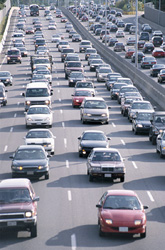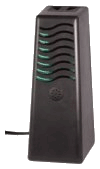New Study Shows Toxic PAH Air Pollution Leads to Genetic Changes and Asthma -- Starting in the Womb
by www.SixWise.com
Women who live in heavy traffic areas such as the Northern Manhattan and South Bronx areas of New York City, could give birth to children with an increased risk of asthma due to what are called toxic PAH’s (Polycyclic Aromatic Hydrocarbons).
|

Children born to mothers who lived near heavy traffic areas while pregnant may have an increased risk of asthma.
|
The finding came from a study of the umbilical cord blood from New York City children, in which researchers found a change in a gene (called ACSL3) associated with prenatal exposure to polycyclic aromatic hydrocarbons.
Most commonly, PAHs are released into the air when fossil fuels, gasoline and garbage are burned, and as such perhaps the most common route of exposure to these chemicals is by breathing contaminated air. PAHs exist in cigarette smoke, wood smoke, vehicle exhaust, diesel exhaust and asphalt roads, as well as in the air of industrial coking, coal-tar and asphalt production facilities, along with trash-incinerating facilities.
Because of this, air in urban areas may have PAH levels 10 times higher than those in rural areas.
While exposure to PAHs has previously been linked to cancer, childhood asthma, cataracts, kidney and liver damage and other diseases, the new study found the chemicals result in epigenetic changes that may disrupt the normal functioning of genes by altering their expression.
"Our data support the concept that environmental exposures can interact with genes during key developmental periods to trigger disease onset later in life, and that tissues are being reprogrammed to become abnormal later," Shuk-mei Ho, University of Cincinnati researcher and lead author of the study, told LiveScience.com.
Where Else Can You be Exposed to PAHs?
PAHs are not only found in heavy traffic areas, they are also created when meats are barbecued, smoked or charbroiled. Other foods, including roasted coffee, roasted peanuts, refined vegetable oils and any food grown in PAH-contaminated soil (such as near a hazardous waste site) may also contain the chemicals, as can processed and pickled foods.
|

PAHs are also created when meats are barbecued, smoked or charbroiled.
|
Polycyclic Aromatic Hydrocarbons can also contaminate soil and water supplies, and certain areas in the United States have shown low-level PAHs in their water. The compounds are so widespread that simply coming into contact with air, water or soil around a hazardous waste site can increase your exposure.
Finally, PAHs are used in certain cosmetics, shampoos and hair dyes (anything that contains coal tar), and you may absorb some of the chemicals if you use these products. They're also present in certain household products, including creosote-treated wood and mothballs.
PAHs are Only One Risky Component of Air Pollution
Two out of every five people, or 42 percent of the U.S. population, live in counties that have unhealthful levels of ozone or particle pollution -- two types of air pollution -- according to the American Lung Association's State of the Air 2008.
In the most polluted cities it has been estimated that lives are shortened by an average of one to two years, according to research by the American Cancer Society and Harvard University, due to this pollution.
For instance, long-term exposure to air pollution, particularly that from motor traffic, increases the risk of fatal heart attacks, according to a study published by the Karolinska Institute, Institute of Environmental Medicine. Air pollution also increases the risk of heart attacks and strokes, and makes respiratory problems worse, by thickening the blood and increasing inflammation, respectively.
How to protect Yourself and Your Family From PAHs and Other Air Pollution Concerns
If you are pregnant and live in a high-traffic area, you should follow commonsense guidelines to minimize your exposure to pollutants, such as:
- Keeping your windows and doors closed and running your air conditioner (make sure the filter is clean)
- Not going outside when pollution levels are highest (typically midday and afternoon)
- Not exercising during rush-hour traffic or near congested streets
- Drinking plenty of fluids to keep your respiratory tract moist
|
Purify Your Air, Fast, With PIONAIR
 With the PIONAIR Air Treatment System you can remove smoke, dust, pet dander, mold, bacteria, pollen and more from your home and office air so you can breathe freely. With the PIONAIR Air Treatment System you can remove smoke, dust, pet dander, mold, bacteria, pollen and more from your home and office air so you can breathe freely.
All PIONAIR Systems include a 30-Day Money-Back Guarantee!
And for a LIMITED TIME ONLY, Get $30 Off Each PIONAIR Air Treatment Unit, Plus FREE SHIPPING and a FREE MiniMate Refrigerator Unit!
Choose Your PIONAIR System and Order Now!
|
To reduce your exposure to PAHs, specifically:
- Quit smoking if you do, and try not to be around second-hand tobacco smoke
- Cut back on, or eliminate, charbroiled, smoked and barbecued foods from your diet
- Reduce your use of wood-burning stoves and fireplaces
- Don't use cosmetics, shampoos and hair dyes that contain coal tar
- Don't use mothballs, moth flakes or deodorant cakes (try cedar shavings or aromatic herbs instead)
- Avoid skin contact with creosote-treated wood products (wear gloves, long pants and long sleeves when handling them
Further, because PAHs are ubiquitous in the environment, and are even found in house dust, we highly recommend regularly dusting your home using the PerfectClean line of mops, dusters, towels and more, which are used by leading hospitals and other health care organizations.
Rather than just pushing dust around, or worse, stirring it up into the air, PerfectClean's EasyGrip Mop and Flexible Duster are made with positively charged ultramicrofibers that pick up everything in their path -- including dust and all of its microscopic attachments. These ultramicrofibers are so small at an astonishing 3 microns that they're even smaller than most bacteria (each cleaning cloth contains over 300 miles of actual cleaning surface!). They pick up contaminants either used dry or dampened with water -- no harsh cleaners needed.
Choosing PerfectClean's ultramicrofiber cloths, mops and wipes are by far the smartest choice -- and the most economical since each cloth can be used over 100 times before being replaced -- for dusting in your home.
The other highly recommended step to creating a clean indoor environment is to purify your indoor air. The PIONAIR Air Treatment System, which Sixwise.com highly recommends, uses photocatalysis, which is designed to oxidize organic odors, germs, and fungi. The PIONAIR technology creates ultraviolet light rays, safe levels of ozone, and passive negative ions as part of your air treatment. This is not just any old air filter -- it is an air purifier that duplicates Nature's own methods of air cleaning and revitalization.
By keeping dust to a minimum, and taking a proactive stance regarding filtering your home’s indoor air, you can breathe freely and have peace of mind when it comes to your home’s air quality.
Recommended Reading
New Research Shows Very High Risk for Developing Asthma from Household Cleaners
12 Steps to Making Your Home an Asthma-Safe Environment
Sources
PLoS ONE February 16, 2009
Yahoo News February 14, 2009